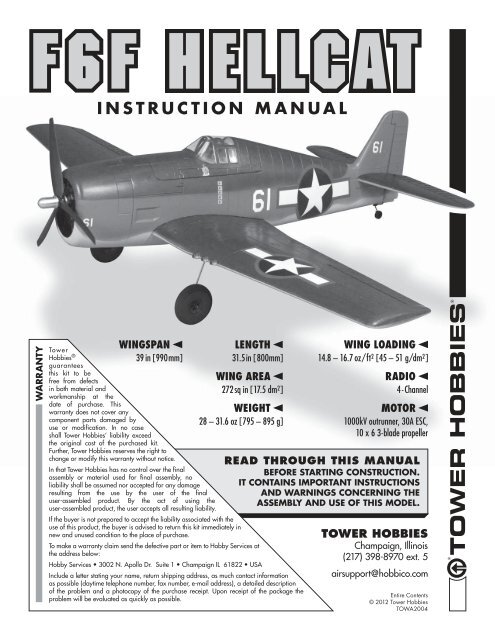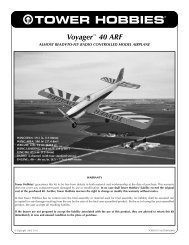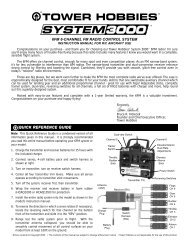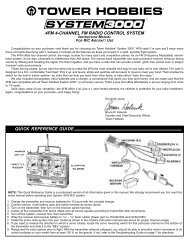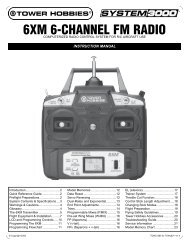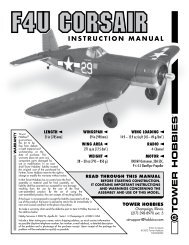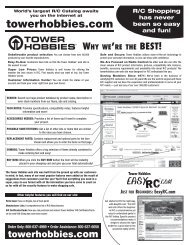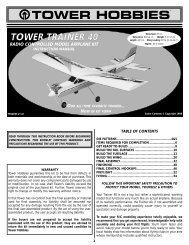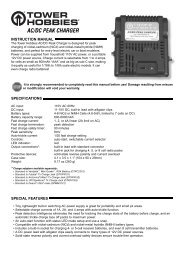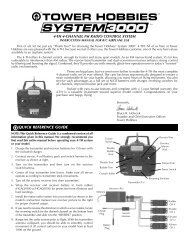Manual 1 - Tower Hobbies
Manual 1 - Tower Hobbies
Manual 1 - Tower Hobbies
Create successful ePaper yourself
Turn your PDF publications into a flip-book with our unique Google optimized e-Paper software.
INSTRUCTION MANUAL<br />
WARRANTY<br />
®<br />
WINGSPAN<br />
39 in [990mm]<br />
<strong>Tower</strong><br />
<strong>Hobbies</strong> ®<br />
guarantees<br />
this kit to be<br />
free from defects<br />
in both material and<br />
workmanship at the<br />
date of purchase. This<br />
warranty does not cover any<br />
component parts damaged by<br />
use or modification. In no case<br />
shall <strong>Tower</strong> <strong>Hobbies</strong>’ liability exceed<br />
the original cost of the purchased kit.<br />
Further, <strong>Tower</strong> <strong>Hobbies</strong> reserves the right to<br />
change or modify this warranty without notice.<br />
In that <strong>Tower</strong> <strong>Hobbies</strong> has no control over the final<br />
assembly or material used for final assembly, no<br />
liability shall be assumed nor accepted for any damage<br />
resulting from the use by the user of the final<br />
user-assembled product. By the act of using the<br />
user-assembled product, the user accepts all resulting liability.<br />
LENGTH<br />
31.5 in [800mm]<br />
WING AREA<br />
272 sq in [17.5 dm 2 ]<br />
WEIGHT<br />
28 – 31.6 oz [795 – 895 g]<br />
If the buyer is not prepared to accept the liability associated with the<br />
use of this product, the buyer is advised to return this kit immediately in<br />
new and unused condition to the place of purchase.<br />
To make a warranty claim send the defective part or item to Hobby Services at<br />
the address below:<br />
<br />
Include a letter stating your name, return shipping address, as much contact information<br />
as possible (daytime telephone number, fax number, e-mail address), a detailed description<br />
<br />
problem will be evaluated as quickly as possible.<br />
WING LOADING<br />
14.8 – 16.7 oz/ft 2 [45 – 51 g/dm 2 ]<br />
RADIO<br />
4-Channel<br />
MOTOR<br />
1000kV outrunner, 30A ESC,<br />
10 x 6 3-blade propeller<br />
READ THROUGH THIS MANUAL<br />
BEFORE STARTING CONSTRUCTION.<br />
IT CONTAINS IMPORTANT INSTRUCTIONS<br />
AND WARNINGS CONCERNING THE<br />
ASSEMBLY AND USE OF THIS MODEL.<br />
TOWER HOBBIES<br />
<br />
<br />
airsupport@hobbico.com<br />
Entire Contents<br />
© 2012 <strong>Tower</strong> <strong>Hobbies</strong><br />
TOWA2004<br />
®
2<br />
TABLE OF CONTENTS ––––––––––––––––––<br />
INTRODUCTION. . . . . . . . . . . . . . . . . . . . . . . . . . . . . . . . .2<br />
SAFETY PRECAUTIONS . . . . . . . . . . . . . . . . . . . . . . . . . .2<br />
REQUIRED FOR COMPLETION . . . . . . . . . . . . . . . . . . .2<br />
LiPo Battery Charger . . . . . . . . . . . . . . . . . . . . . . . . . . . .2<br />
KIT INSPECTION . . . . . . . . . . . . . . . . . . . . . . . . . . . . . . . .3<br />
ORDERING REPLACEMENT PARTS . . . . . . . . . . . . . . .3<br />
CONTENTS . . . . . . . . . . . . . . . . . . . . . . . . . . . . . . . . . . . . . .3<br />
MAIN ASSEMBLY. . . . . . . . . . . . . . . . . . . . . . . . . . . . . . . .4<br />
FINAL ASSEMBLY. . . . . . . . . . . . . . . . . . . . . . . . . . . . . . . .5<br />
Hook Up the Controls . . . . . . . . . . . . . . . . . . . . . . . . . . .5<br />
Check the Control Throws . . . . . . . . . . . . . . . . . . . . . . . .6<br />
Check the C.G.. . . . . . . . . . . . . . . . . . . . . . . . . . . . . . . . .6<br />
MOTOR SAFETY PRECAUTIONS . . . . . . . . . . . . . . . . . 7<br />
MOTOR/ESC OPERATION . . . . . . . . . . . . . . . . . . . . . . .8<br />
FLYING. . . . . . . . . . . . . . . . . . . . . . . . . . . . . . . . . . . . . . . . . .8<br />
REPAIRS. . . . . . . . . . . . . . . . . . . . . . . . . . . . . . . . . . . . . . . . .8<br />
INTRODUCTION ––––––––––––––––––––––––<br />
Thank you for purchasing the <strong>Tower</strong> <strong>Hobbies</strong> EP Hellcat. Not<br />
quite as much the “household” name as your Mustangs or Corsairs,<br />
the Hellcat is every bit as impactful when you see it in person—<br />
whether it’s the model or the real thing! But hey, what to say about<br />
this <strong>Tower</strong> <strong>Hobbies</strong> Hellcat There’s not really much to it other<br />
than an economical, durable and simple model with considerable<br />
surface and scale detail and it flies great! Get it together, head to<br />
your flying site, get it into the air and have fun!<br />
For the latest technical updates or manual corrections to the<br />
Hellcat, visit the <strong>Tower</strong> <strong>Hobbies</strong> web site at www.towerhobbies.<br />
com. Open the “Airplanes” link, then select the EP Hellcat ARF.<br />
If there is new technical information or changes to this model a<br />
“tech notice” box will appear in the upper left corner of the page.<br />
AMA<br />
If you are not already a member of the AMA, please join! The<br />
AMA is the governing body of model aviation and membership<br />
provides liability insurance coverage, protects modelers’ rights<br />
and interests and is required to fly at most R/C sites.<br />
Academy of Model Aeronautics<br />
5151 East Memorial Drive<br />
Muncie, IN 47302-9252<br />
Tele. (800) 435-9262<br />
Fax (765) 741-0057<br />
Or via the Internet at: www.modelaircraft.org<br />
IMPORTANT: Two of the most important things you can do to<br />
preserve the radio controlled aircraft hobby are to avoid flying near<br />
full-scale aircraft and avoid flying near or over groups of people.<br />
SAFETY PRECAUTIONS ––––––––––––––––<br />
PROTECT YOUR MODEL, YOURSELF & OTHERS…<br />
FOLLOW THESE IMPORTANT SAFETY PRECAUTIONS<br />
1. Your EP Hellcat should not be considered a toy, but rather a<br />
sophisticated, working model that functions very much like a<br />
full-size airplane. Because of its performance capabilities, the<br />
Hellcat, if not assembled and operated correctly, could possibly<br />
cause injury to yourself or spectators and damage to property.<br />
2. You must assemble the Hellcat according to the instructions.<br />
Do not alter or modify the model, as doing so may result in an<br />
unsafe or unflyable model. In a few cases the instructions may<br />
differ slightly from the photos. In those instances the written<br />
instructions should be considered as correct.<br />
3. You must use an R/C radio system that is in good condition.<br />
All components must be correctly installed so that the model<br />
operates correctly on the ground and in the air. You must check<br />
the operation of the model and all components before every flight.<br />
4. If you are not an experienced pilot or have not flown this type<br />
of model before, we recommend that you get the assistance<br />
of an experienced pilot in your R/C club for your first flights.<br />
If you’re not a member of a club, your local hobby shop has<br />
information about clubs in your area whose membership includes<br />
experienced pilots.<br />
5. While this kit has been flight tested to exceed normal use, if the<br />
plane will be used for extremely high stress flying, such as racing,<br />
or if a motor or battery larger than ones in the recommended range<br />
is used, the modeler is responsible for taking steps to reinforce<br />
the high stress points and/or substituting hardware more suitable<br />
for the increased stress.<br />
We, as the kit manufacturer, provide you with a top quality,<br />
thoroughly tested kit and instructions, but ultimately the<br />
quality and flyability of your finished model depends on how<br />
you build it; therefore, we cannot in any way guarantee the<br />
performance of your completed model, and no representations<br />
are expressed or implied as to the performance or safety of<br />
your completed model.<br />
REMEMBER: Take your time and follow the instructions to<br />
end up with a well-built model.<br />
REQUIRED FOR COMPLETION –––––––––<br />
No extraordinary tools or building supplies are required to<br />
finish the EP Hellcat—just a Phillips screwdriver. The Hellcat<br />
is already equipped with servos, ESC and motor, so the only<br />
other components you have to supply are as follows:<br />
■ Minimum 4-channel transmitter and receiver<br />
■ 3S 11.1V 1800mAh ̶ 2200mAh LiPo battery:<br />
Electrifly 2200mAh 30C (GPMP0681)<br />
FlightPower 2100mAh 25C (FPWP4196)<br />
FlightPower 2200mAh 30C (FPWP6198)<br />
Flyzone 2100mAh 20C (FLZA6173)<br />
(See page 6 for more about batteries.)<br />
■ LiPo battery charger<br />
NOTE: If using a battery with a Deans ® Ultra Plug ® connector,<br />
a Deans Ultra Male-to-SuperTigre ESC adapter (SUPM0040)<br />
will also be required (or the connector on the ESC may simply<br />
be replaced with a Deans Ultra Male connector).
LiPo Battery Charger<br />
Most modelers may already have a suitable LiPo charger, but for<br />
those that do not, the Duratrax Onyx 235 AC/DC Advance Peak<br />
Charger (DTXP4235) is one of the suitable chargers recommended.<br />
The Onyx charger is perfect for 3S batteries used with the Hellcat<br />
and may be powered either by an external DC power source<br />
(such as a 12 battery), or a 110V AC outlet. The Onyx also has<br />
an adjustable charge rate to charge your batteries in as little as a<br />
half-hour or less (depending on the condition of your batteries<br />
and the manufacturer’s specified charge rate). The Onyx can also<br />
charge larger batteries and batteries other than LiPos, so it is a<br />
versatile charger you can grow into. The 235 also has an LCD<br />
digital display screen, so you can see how much capacity it took<br />
to recharge the battery (required for monitoring the condition of<br />
your batteries and calculating how long you can fly).<br />
NOTE: For use with the Onyx 235, LiPo batteries that come<br />
with a SuperTigre connector (such as the Flyzone batteries<br />
recommended) require a banana plugs-to-SuperTigre charge<br />
lead (SUPM0070). And batteries that come with a Deans Ultra<br />
connector require a Charge Lead with banana plugs/Deans Ultra<br />
Male charge lead (GPMM3148).<br />
KIT INSPECTION –––––––––––––––––––––––<br />
Before assembly, take an inventory of this kit to make sure it is<br />
complete, and inspect the parts to make sure they are of acceptable<br />
quality. If any parts are missing or are not of acceptable quality, or<br />
if you need assistance with assembly, contact Product Support.<br />
When reporting defective or missing parts, use the part names<br />
exactly as they are written in the Kit Contents list.<br />
Hobbico Product Support Ph: (217) 398-8970 ext. 5<br />
3002 N Apollo Drive Suite 1 Fax: (217) 398-7721<br />
Champaign, IL 61822<br />
E-mail: airsupport@hobbico.com<br />
ORDERING REPLACEMENT PARTS ––––<br />
Replacement parts for the <strong>Tower</strong> <strong>Hobbies</strong> EP Hellcat are available<br />
using the order numbers in the Replacement Parts List that<br />
follows. The fastest, most economical service can be provided<br />
by your hobby dealer or mail-order company.<br />
To locate a hobby dealer, visit the Hobbico web site at www.<br />
hobbico.com. Choose “Where to Buy” at the bottom of the menu<br />
on the left side of the page. Follow the instructions provided on<br />
the page to locate a U.S., Canadian or International dealer.<br />
Parts may be ordered directly from Hobby Services by calling<br />
(217) 398-0007, or via facsimile at (217) 398-7721, but full retail<br />
prices and shipping and handling charges will apply. Illinois<br />
and Nevada residents will also be charged sales tax. If ordering<br />
via fax, include a Visa ® or MasterCard ® number and expiration<br />
date for payment.<br />
Mail parts orders Hobby Services<br />
and payments by 3002 N Apollo Drive, Suite 1<br />
personal check to: Champaign IL 61822<br />
Be certain to specify the order number exactly as listed in the<br />
Replacement Parts List. Payment by credit card or personal<br />
check only; no C.O.D.<br />
If additional assistance is required for any reason contact Product<br />
Support by e-mail at productsupport@hobbico.com, or by<br />
telephone at (217) 398-8970.<br />
Order No.<br />
TOWA6095<br />
TOWA6096<br />
TOWA6097<br />
TOWA6098<br />
TOWA6099<br />
TOWA6100<br />
TOWA6101<br />
TOWA6102<br />
TOWA6103<br />
GPMQ1888<br />
TOWA6092<br />
TOWM5500<br />
SUPM1030<br />
TOWG2000<br />
REPLACEMENT PARTS LIST<br />
Description<br />
Wing<br />
Fuselage<br />
Horizontal Stabilizer<br />
Vertical Stabilizer<br />
Cowl<br />
Canopy/Hatch<br />
Wing Bolt ( 2 pcs. )<br />
Landing Gear<br />
10x6 3 Blade Propeller<br />
Tail Gear<br />
Spinner Hub<br />
Servo<br />
30A Brushless ESC<br />
1000kV Outrunner Motor<br />
––––––––––––––––––––––––––––––––––– CONTENTS ––––––––––––––––––––––––––––––––––––<br />
1<br />
3<br />
1. Fuselage, Cowl, Canopy Hatch<br />
2. Wing<br />
3. Vertical Stabilizer<br />
4. Horizontal Stabilizer<br />
5. Hardware Bag<br />
6. Main Landing Gear<br />
7. Propeller Hub<br />
8. Propeller<br />
2<br />
8<br />
4<br />
7<br />
6<br />
5<br />
3
MAIN ASSEMBLY ––––––––––––––––––––––<br />
NOTE: If you haven’t yet figured it out yet, the canopy hatch<br />
is held to the fuselage with magnets at the rear and a tab at the<br />
front. To remove the hatch, simply lift up on the aft end of the<br />
hatch to disengage the magnets.<br />
❏ 3. Connect the pushrods to the horns as shown.<br />
❏ 4. Insert one, then the other main landing gear wires into<br />
the wing – the wire struts are positioned inboard of the wheels.<br />
❏ 1. Fit the horizontal and vertical stabilizer (stab and fin)<br />
together, then fit them to the fuselage while keying the tail gear<br />
into the rudder.<br />
4<br />
❏ 2. Fasten the stab and fin assembly to the fuselage with the<br />
M3 x 40 screw.<br />
❏ 5. Guide the aileron servo wire through the hole in the bottom<br />
of the wing.
❏ 6. Bolt the wing to the fuselage with the M6 x 50mm nylon<br />
wing bolt—don’t over tighten the bolt—just enough to securely<br />
“snug” the wing up to the fuselage.<br />
❏ 2. Use the included double-sided foam mounting strip to<br />
mount the receiver in the fuselage out of the way where it will<br />
not interfere with installation and removal of the battery.<br />
❏ 3. Without the propeller yet mounted, temporarily place the<br />
battery in the fuselage, turn on your transmitter and connect the<br />
battery to the ESC to power the system up so you can check the<br />
controls.<br />
❏ 7. Apply the rougher, “hook” side of the included hook-andloop<br />
material to the fuselage floor and the softer, “loop” side to<br />
the battery.<br />
FINAL ASSEMBLY ––––––––––––––––––––––<br />
Hook Up the Controls<br />
❏ 1. Connect the servo and ESC wires to the appropriate channels<br />
in your receiver.<br />
❏ 4. Make sure all the controls respond in the correct direction<br />
according to your inputs and that all the control surfaces are<br />
centered—if necessary, use the servo reversing in your transmitter<br />
and adjust the pushrods in the screw-lock connectors to center<br />
the controls. Whether or not you adjusted any pushrods, doublecheck<br />
that the screw in all the screw-lock connectors are<br />
tight and secure.<br />
5
Check the Control Throws<br />
Check the C.G.<br />
The C.G. (center of gravity) has a great effect on the way the<br />
Hellcat flies. If the C.G. is not correct the Hellcat could be too<br />
stable (reacting too slowly to control inputs) or too instable<br />
(reacting too quickly to control inputs) possibly causing a crash.<br />
LESS control throw<br />
MORE control throw<br />
MORE<br />
control<br />
throw<br />
LESS<br />
control<br />
throw<br />
Raise the aft end of the fuselage so the wings and stab are level (or<br />
nearly level). Measure the control surface throws and if necessary,<br />
use the programming in your transmitter or change the location<br />
of the pushrods in the servo arms or in the horns on the control<br />
surfaces to get the recommended throws. Note that the throws<br />
are measured at the widest part (front-to-back) of each surface:<br />
The Hellcat is designed to fly with either an 1800mAh or<br />
2100mAh 3S (11.7V) battery, but it could use a little help in<br />
the C.G. department and will benefit from the slightly heavier<br />
2100mAh battery. The Hellcat should balance pretty much on<br />
the recommended C.G. location with a 3S 2100mAh battery<br />
positioned as far forward as it will go. It will still balance within<br />
the recommended range with an 1800mAh battery all the way<br />
forward, but to get it balanced directly on the recommended<br />
point approximately .75 oz. [21g] may be required in the nose.<br />
After checking the C.G., should you decide to stick an ounce<br />
or so of ballast in the nose it is acceptable to do so directly to<br />
the inside of the cowl. Eventually though the adhesive on the<br />
double-sided foam tape on the back of most lead strips will<br />
let go, so once you’ve finalized the amount of weight, attach<br />
it more securely with a few drops of CA.<br />
If your radio does not have dual rates, we recommend setting the<br />
throws halfway between the high and low rates.<br />
THESE ARE THE RECOMMENDED CONTROL SURFACE THROWS:<br />
HIGH RATE<br />
LOW RATE<br />
ELEVATOR<br />
UP<br />
7/16" [11mm]<br />
13°<br />
DOWN<br />
7/16" [11mm]<br />
13°<br />
UP<br />
1/4" [6mm]<br />
7°<br />
DOWN<br />
1/4" [6mm]<br />
7°<br />
RUDDER<br />
AILERONS<br />
RIGHT<br />
3/4" [19mm]<br />
19°<br />
UP<br />
1/2" [13mm]<br />
17°<br />
LEFT<br />
3/4" [19mm]<br />
19°<br />
DOWN<br />
1/2" [13mm]<br />
17°<br />
RIGHT<br />
1/2" [13mm]<br />
13°<br />
UP<br />
3/8" [10mm]<br />
12°<br />
LEFT<br />
1/2" [13mm]<br />
13°<br />
DOWN<br />
3/8" [10mm]<br />
12°<br />
❏ 1. With the battery disconnected, mount the propeller to the<br />
motor with the included collet adapter hub—for now the propeller<br />
hub needs to be only finger tight (in case the cowl requires removal<br />
for adding ballast to the nose later).<br />
6
❏ 2. If you haven’t done so already, install the battery—as<br />
previously suggested, start with the battery positioned as far<br />
forward as it will go.<br />
❏ 4. Lift the model upside-down with your fingertips on the<br />
recommended C.G. location you marked.<br />
❏ 5. If necessary, shift the battery forward or aft or add stick-on<br />
lead ballast where required to get the model to balance.<br />
Recommended<br />
Starting C.G.<br />
2-5/8" [67mm]<br />
Back From Wing LE<br />
at Fuselage Sides<br />
Forward Limit:<br />
2-1/4" [57 mm]<br />
Aft Limit:<br />
3" [76 mm]<br />
2-5/8" [67mm] 2-5/8" [67mm]<br />
❏ 6. Once the C.G. has been set, tighten the propeller hub using<br />
a small screwdriver as a torque bar.<br />
MOTOR SAFETY PRECAUTIONS –––––––<br />
Failure to follow these safety precautions may result in severe<br />
injury to yourself and others.<br />
■ Seek the assistance of an experienced pilot if new to electric<br />
motors.<br />
■ Wear safety glasses whenever in the proximity of a spinning<br />
propeller.<br />
■ Do not operate the motor in an area of loose gravel or sand;<br />
the propeller may throw such material in your face or eyes.<br />
❏ 3. The C.G. is to be marked on the top of the wing so that<br />
you can see where to position your fingers for lifting the model<br />
for balancing, or better yet, so that you can actually feel the<br />
marks. You could use a fine-point, felt-tip pen, or something<br />
inconspicuous or removable such as pins inserted directly into<br />
the foam that can be removed later. Whatever method you use,<br />
mark the C.G. on the top of the wing where indicated.<br />
■ Keep spectators as well as your own face and body out of<br />
the plane of rotation of the propeller.<br />
■ Keep all loose clothing, long hair or any other loose objects<br />
such as pencils or screwdrivers that may fall out pockets<br />
away from the propeller.<br />
NOTE: The Hellcat may be flown with the C.G. up to 3/8”<br />
[10mm] ahead or 3/8” [10mm] behind the recommended<br />
balance point. With the Hellcat balanced at the front of the range<br />
it will be more stable, but less maneuverable and heavier due<br />
to the ballast that may be required. With the Hellcat balanced<br />
at the rear of the range the Hellcat will be more maneuverable,<br />
but less stable and quicker to react to your control inputs.<br />
7
8<br />
MOTOR/ESC OPERATION –––––––––––––<br />
Turning on the transmitter and operating the motor are intuitive<br />
for most pilots who already have experience with electric motors,<br />
but for those who may have little or no experience with electric<br />
motors here are operating instructions for the ESC and motor<br />
included with your Hellcat:<br />
When ready to run up the motor, first turn on the transmitter and<br />
make sure the throttle stick is all the way down. Then connect<br />
the battery to the ESC. The ESC will send a single, short pulse<br />
to the motor, causing it to beep once (“beep”). To operate the<br />
motor advance the throttle stick, hold it there momentarily, and<br />
listen for another single beep (“beep”). Then return the throttle<br />
stick all the way down.The motor will sound two more quick<br />
beeps (“beep beep”). The next time the throttle stick is advanced,<br />
the propeller will turn. You are now ready to fly.<br />
If the transmitter is not turned on before the battery and ESC<br />
are connected (so the receiver is not receiving a signal), the<br />
motor will beep rapidly (“beep beep beep beep…”) until either<br />
the battery is disconnected or the transmitter is turned on. Then,<br />
the ESC will resume its normal arming sequence.<br />
If, when the battery is connected to the ESC, the throttle stick<br />
is not all the way down the motor will beep steadily (“beep,”<br />
“beep,” “beep…”) until either the battery is disconnected or the<br />
throttle stick is returned to the off position. This time the ESC<br />
will resume its normal arming sequence.<br />
FLYING –––––––––––––––––––––––––––––––––<br />
The Hellcat doesn’t exhibit any particular characteristics that you<br />
need to be made aware of ahead of time, other than it is a slightly<br />
“draggy” airframe that will benefit from a few clicks of throttle<br />
while dragging it in for a landing—just let the Hellcat settle and<br />
it will touch down smoothly. Then, cut the throttle.<br />
Flying “normally,” the Hellcat consumes approximately 250mAh/<br />
minute which should provide approximately 6-1/2 to 7 minutes of<br />
motor run time on a 2100mAh battery—of course, the run time<br />
you can expect depends on many factors such as the condition<br />
of your batteries, your flying style and even the wind conditions<br />
(flying on windy days seems to use more power than flying on<br />
calm days).<br />
To find out for yourself how long you can fly, set your timer to<br />
a conservative 5 minutes. Fly until the timer sounds, then land.<br />
Use a charger with a digital display to find out how much capacity<br />
it took to recharge the battery (indicating how much capacity<br />
was used). To avoid over discharging your LiPos, likely causing<br />
reduced performance, the target is to use 80% of your battery’s<br />
capacity, so multiply your battery’s capacity by .8 to find out how<br />
This model belongs to:<br />
Name<br />
Address<br />
City, State, Zip<br />
Phone Number<br />
AMA Number<br />
much you have available. Compare the capacity used to 80% of<br />
your battery’s capacity and adjust your flight time accordingly.<br />
FOR EXAMPLE: If using the recommended 2100mAh battery,<br />
your target capacity available is 1680mAh (2100mAh x .8). If you<br />
fly for five minutes and it takes 1200mAh to recharge your battery,<br />
you still had 480mAh to go, so adjust your timer to increase your<br />
flight time accordingly until you reach your 1680mAh target.<br />
(You could also divide 1200mAh by five minutes to figure a<br />
current consumption rate of 240mAh/minute. Divide 1680mAh<br />
by 240mAh/minute to conclude that you can fly for 7 minutes.)<br />
It’s also a great idea to use a LiPo battery checker (HCAP0275)<br />
to check the battery before each flight (to make sure you haven’t<br />
inadvertently grabbed a discharged battery) and to check the<br />
battery after flight to make sure you haven’t over discharged<br />
your battery by flying too long. A safe, conservative, minimum<br />
voltage is 3.65V – 3.7V per cell right after a flight.<br />
REPAIRS –––––––––––––––––––––––––––––––<br />
Parts damaged beyond repair can be purchased separately. The<br />
full replacement part list is printed in the front of the manual on<br />
page 3. Often though, parts can be repaired and you can get your<br />
Hellcat back into the air with a little glue and ingenuity.<br />
The Hellcat is made from injection-molded EPO (expanded<br />
polyolefin) foam which can be glued with just about anything.<br />
Most people use regular CA. With CA no clamping is required,<br />
but some prefer softer, more flexible adhesives such as white<br />
glue or canopy glue. These kinds of glues will require clamps<br />
or tape to hold the parts together while the glue dries.<br />
One final note about flying your model. Have a goal or flight plan<br />
in mind for every flight. This can be learning a new maneuver(s),<br />
improving a maneuver(s) you already know, or learning how<br />
the model behaves in certain conditions (such as on high or low<br />
rates). This is not necessarily to improve your skills (though it is<br />
never a bad idea!), but more importantly so you do not surprise<br />
yourself by impulsively attempting a maneuver and suddenly<br />
finding that you’ve run out of time, altitude or airspeed. Every<br />
maneuver should be deliberate, not impulsive. For example, if<br />
you’re going to do a loop, check your altitude, mind the wind<br />
direction (anticipating rudder corrections that will be required to<br />
maintain heading), remember to throttle back at the top, and make<br />
certain you are on the desired rates (high/low rates). A flight plan<br />
greatly reduces the chances of crashing your model just because<br />
of poor planning and impulsive moves. Remember to think.<br />
Have a ball! But always stay in control and fly in a safe manner.<br />
GOOD LUCK AND GREAT FLYING!


